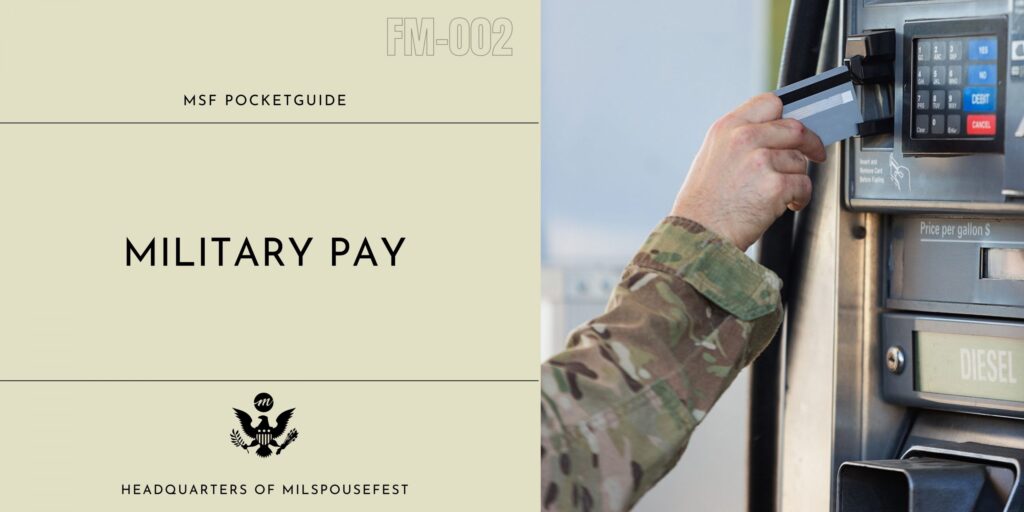Military pay is not simple, there are many different factors that go into it. In this edition of the MSF Military Pocket Guide, we will break down all the different aspects in a service member’s pay.
Basic Pay, Special and Incentives, and Allowances
Basic pay is the fundamental part of a military paycheck. All service members receive basic pay and it is usually the largest sum. A member’s pay grade or rank and years of service determines the amount of basic pay received. There are no major differences in pay between the different military branches, however there is a different pay chart for active duty and reservists.
You can use this handy military pay calculator to see how much you can get.
On top of basic pay, there are special and incentive pays one can receive. Special pays are additional funds provided that are based on specific working environments or jobs. Special pays can be used to improve recruiting and retention by increasing compensation in key occupation specialties or critical skill areas. Currently, there are 60 different types of special pay authorized by law. Here are some examples of S&I:
- Hazardous Duty, for those working in hazardous environments such as parajumping
- Hardship Duty, for those who work in areas where the standard of living is significantly lower than average
- Assignment Incentive pay, for those who choose to take an extension in a specific assignment or tour
There are many more S&I that relate to naval duties like diving and submarine, as well as S&I for nursing, medical, and dental duties.
Allowances are the second most important part of military pay. Allowances are monies provided for specific needs, such as food or housing. Monetary allowances are provided when the government does not provide for that specific need. The most common allowances are Basic Allowance for Subsistence (BAS) and Basic Allowance for Housing (BAH), and a majority of the force receives both of these allowances. We will discuss BAH and BAS in another article, but other allowances include:
- Clothing, that provides money to purchase uniforms
- Dislocation, that partially reimburses a servicemember for the expenses incurred in relocating the member’s household on a PCS, housing moves ordered for the Government’s convenience, or incident to an evacuation
- FSA, or Family Separation Allowance, for a servicemember with dependents who serves an unaccompanied tour of duty and is entitled to a FSA of $250 per month
- FSSA, or Family Supplemental Subsistence Allowance, for service members who fall on hard economic times
Continental United States Cost of Living Allowance (CONUS COLA) is a supplemental allowance designed to help offset higher prices in the highest cost locations in CONUS that exceed the costs in an average CONUS location by 8 percent or more. The program affects approximately 54,000 Service members in 21 Military Housing Areas (MHAs) and 21 other counties in CONUS.
The Overseas Cost of Living Allowance (OCONUS COLA) is a non-taxable allowance designed to offset the higher overseas prices of non-housing goods and services. It affects approximately 250,000 Service members at 600 locations overseas, including Alaska and Hawaii. Approximately $2 billion is paid in Overseas Cost of Living Allowances annually. OCONUS COLA is intended to equalize purchasing power so that Service members can purchase the same level of goods and services overseas as they could if they were stationed in CONUS.
Taxes in Military Pay
A big part of military pay is certain built-in tax advantages. Most allowances, including BAH and BAS, are tax-exempt and certain hardship circumstances can make what is usually taxable into tax-exempt. Combat Zone Tax Exclusions are applied to those service members who currently serve in a combat zone. If you spend a single qualifying day in the combat zone, your pay for the entire month is excluded from taxable income.
CONUS COLA is taxable, while OCONUS COLA is non-taxable.
Are there raises in military pay?
Raises in military pay are generally distributed should a service member get promoted or should the service member hit a new benchmark in years of service.
Unless Congress and/or the President act to set a different military basic pay raise, annual military basic pay raises are linked to the increase in private-sector wages, as measured by the Employment Cost Index (ECI). ECI is a measure of the increase in private-sector wages and salaries, and is calculated by the Department of Labor’s Bureau of Labor Statistics and updated every three months. The ECI, reported each October, is used to determine the pay raise for the next fiscal year.
Currently, military pay changes for 2022 are working its way through the US Congress and Senate, as reported by Military Times. “One of the things that Chairman Adam Smith and I have been talking about — and we intend to lean into next year — is significantly increasing compensation and benefits packages, particularly for enlisted personnel,” said Rep. Mike Rogers, R-Ala.


















